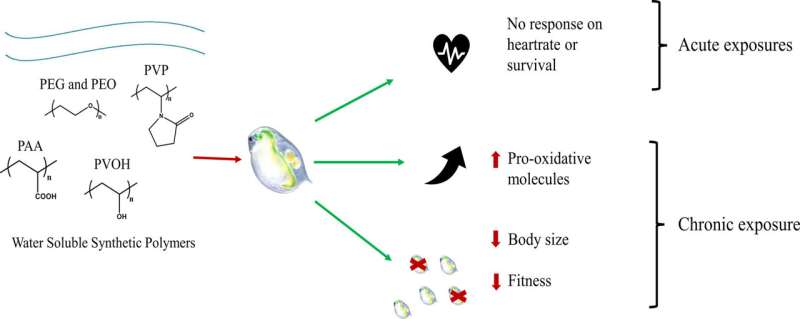Case study discovers ecological impact of water-soluble polymers

Water-soluble synthetic polymers (WSSPs) are found in many everyday products. What the consequences are when these plastics enter rivers, lakes and oceans is still largely unexplored. A team from the University of Bayreuth has now systematically investigated the effects on water fleas of the species Daphnia magna for the first time.
The polymers selected for testing significantly alter the body size and reproduction of the animals in some cases. The research, published in Science of The Total Environment, shows that water-soluble polymers could have consequences for biodiversity and food chains in aquatic ecosystems that should not be underestimated.
Textiles, paints, paper, adhesives, cosmetics and pharmaceuticals are just a few examples of industrial products that contain water-soluble synthetic polymers (WSSPs). In addition, WSSPs are used in wastewater treatment and stormwater treatment.
Nevertheless, little is known about their concentrations in the environment. They are not visible here, unlike plastic waste and microplastic particles. However, the presence of WSSPs in rivers, lakes and other freshwater repositories has been demonstrated in various studies.
Researchers of the CRC 1375 "Microplastics" and the International Training Network (ITN) "LimnoPlast" at the University of Bayreuth have now selected five commercially available polymers that are used frequently in industry for production. Using biological and chemical methods, they have investigated how water fleas of the species Daphnia magna react to WSSP.
In ecological research, this species serves as a model organism on which interactions between potential pollutants and living organisms can be readily observed. The polymers dissolved in the water with which the water fleas were in constant contact during the tests were polyvinyl alcohol (PVOH), polyvinyl pyrrolidone (PVP), polyacrylic acid (PAA), polyethylene glycol (PEG) and polyethylene oxide (PEO).
"Water fleas have a key ecological function in many freshwater lakes: they have a significant impact on the amount of available phytoplankton, which forms the basis of food chains in lakes. When water fleas are damaged by water-soluble polymers, the consequences can extend to higher levels of the food chain, affecting the entire food web of an ecosystem," says Prof. Dr. Christian Laforsch, spokesperson of the CRC Microplastics and the ITN "LimnoPlast", who coordinated the new interdisciplinary study.
As the research results show, WSSPs are not immediately life-threatening for water fleas. Even their heart rate remains constant when they live in water enriched with WSSP for a long time.
This is a clear indication that the polymers do not cause acute physiological changes. However, the reproductive behavior of the animals changes in two ways: the reproductive cycles lengthen, so that the water fleas produce offspring only at longer intervals. In addition, the number of offspring produced per cycle decreases.
This could have an impact on population growth and thus on the entire foodweb. In addition, the body size of the daphnia also changes under the influence of WSSP.
"Research results to date do not yet provide a precise understanding of the causal effects that led to the significant changes in body size and reproduction of water fleas. Measurements suggest that higher molecular weight of WSSP might be associated with increased toxicity. This is further evidence of the relevance of interdisciplinary research involving cooperation between environmental sciences and polymer chemistry," says the first author of the new study, Bayreuth doctoral student Simona Mondellini M.Sc.
Research into the ecological effects of water-soluble synthetic polymers is currently still in its infancy in many respects. However, the results of the new study on the model organism Daphnia magna exemplify the importance of this research topic.
"Effects of potential contaminants on reproduction and body size of organisms are now established parameters in ecotoxicology. If water fleas change in these respects under the influence of commercial WSSPs used in many industries, this should be an occasion for further targeted studies. After all, the toxic effects of pollutants that spread in the environment usually do not affect individual organisms alone, but also larger populations and widely ramified foodwebs—and thus also the viability and functionality of entire ecosystems," says Prof. Dr. Christian Laforsch.
More information: Simona Mondellini et al, Beyond microplastics: Water soluble synthetic polymers exert sublethal adverse effects in the freshwater cladoceran Daphnia magna, Science of The Total Environment (2022). DOI: 10.1016/j.scitotenv.2022.157608
Journal information: Science of the Total Environment
Provided by Bayreuth University





















